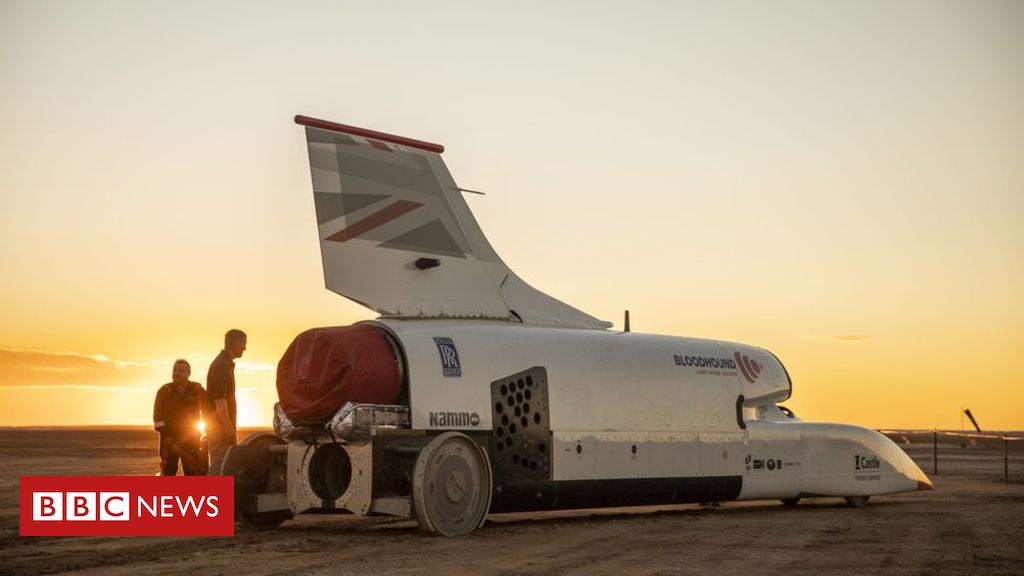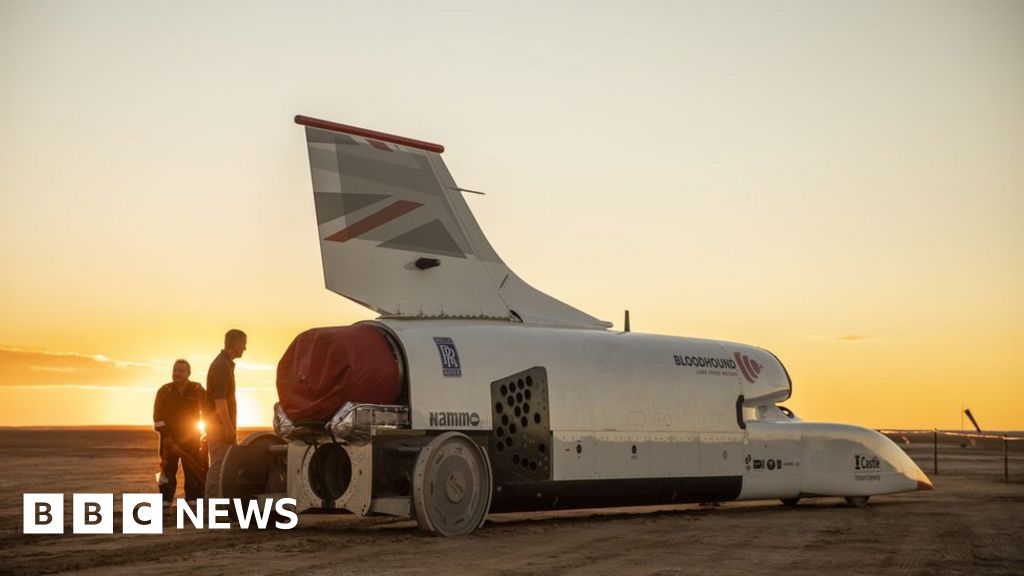Bloodhound diary: Planning the next steps
Driver Andy Green describes what needs to be done to achieve a land speed record. …


A British team is developing a car that will be capable of reaching 1,000mph (1,610km/h). Powered by a rocket bolted to a Eurofighter-Typhoon jet engine, the vehicle aims to show its potential by going progressively faster, year after year. Recent high-speed trials saw Bloodhound hit 628mph (1,010km/h). The next step would be to break the existing world land speed record (763mph; 1,228km/h). The racing is conducted on Hakskeen Pan in Northern Cape, South Africa.
Now that Bloodhound is back in the UK, we are busy planning for the next step of the adventure.
With last year’s hugely successful High Speed Test programme completed, we’ve got lots of data to work through.
There’s also a rocket system to fit, which will blast the car from last year’s jet-powered 628mph to next year’s 800+ mph target.
First, though, we’ve got to secure the rest of the sponsorship for a new World Land Speed Record.
The good news is that we’ve now got a really strong commercial case for potential backers.
We can show that the car is fast – really fast – with plenty of performance next year to set a stunning new record.
Just as importantly for any potential sponsor, we can show that there is a real global interest in this project.
Our recent High Speed Testing generated almost £50m of something called “advertising value equivalent” (AVE).
This is a measure of how much money you’d have to spend in adverts to achieve the same media coverage.
Sponsors understandably want an AVE that is several times as big as their investment.
Here’s the good news – Bloodhound’s testing generated a “return on investment” of between 10 and 15 times, which is a huge number for a sponsorship event.
Of course, that’s not counting the millions of Facebook/YouTube/Twitter followers (thank you all!), or the BBC’s excellent 30-minute documentary which was shown over a dozen times during the Christmas period.
There’s also a one-hour documentary in production right now (details to follow). This is what success looks like – and this is only for testing.
Just imagine the coverage next year, when sonic booms reverberate down our South African race track as we smash through 800mph.
There must be someone out there who wants to share in this global adventure and, based on the commercial discussions we’re having right now, we’re going to find them!
Once we’ve got the funding sorted, we can crack on with the rocket programme.
Last year Bloodhound got to 628mph (1,010 km/h) using just the jet engine.
Adding the rocket motor will give us another 75% increase in thrust.
As our Chief Engineer Mark Chapman observed: “If you think it looks fast now, wait until you see the rocket fire.”
For next year’s 800+ mph record runs, we are planning to use a monopropellant rocket, which uses a catalyst pack to decompose concentrated hydrogen peroxide (known as high-test peroxide, or HTP).
Pumping the HTP over a silver-based catalyst will break the molecules down, releasing a huge amount of energy as it does so: H₂O₂ goes to H₂O plus O₂ plus lots of heat (the exhaust comes out at about 600C).
The rocket exhaust blasts out at Mach 3, or 3 times the speed of sound, about 2,200mph. Blimey. As Mark said, “…just wait until you see the rocket fire…”.
The pumping system to make this happen is quite challenging. We need to generate 50-60 kN (5-6 tonnes) of thrust.
That requires us to pump about 40kg of HTP per second, at about 70-80 Bar.
This is the equivalent of filling your bath at home in three seconds, at 1,000psi.
To deliver this kind of flow rate and pressure, the pump will need 500-600hp to run it.
Fortunately, technology has finally caught up with our pump demands, so we’re going to ditch the big petrol engine and go all-electric for the rocket system.
Bloodhound is going to be the world’s first plug-in hybrid Land Speed Record car, thanks to our “green” rocket system.
The car will literally be blasted along on a high-pressure jet of steam and oxygen.
The Nammo engineers who are building the rocket joined us out on Hakskeen Pan last year during our test runs.
This gave them a chance to see how and where their rocket would operate, how we would refuel the vehicle, and so on.
The extraordinary thing is how small the rocket motor will be (they explain it in more detail here).
It’s less than half a metre in diameter and about the same length. This will allow it to bolt directly on to the current “thrust plate” at the rear of the car.
Installing the pump, electric motors, battery pack, control system and so on may be slightly more complicated, but nothing that Bloodhound LSR’s remarkable engineering team can’t deliver.
For our 800mph runs, the other major change we need is to activate the airbrakes.
We tested the airbrake panels last year, locking them out into the airflow to confirm the drag predictions.
Turbulent high-speed airflow is pretty much impossible to model accurately, so testing is always advised.
The airbrakes worked perfectly, giving almost exactly the expected structural loads and aerodynamic drag forces. With these panel loads confirmed, we now need to fit the actuation system, to force the huge carbon-fibre panels out into the airflow at 400-500mph.
The airbrakes will easily stop the car before the end of our 12-mile track.
However, the stopping bit of the run is one bit that we need to get right every single time.
To guarantee that we can stop the car in the event of a systems failure, we will have three different options next year: the airbrakes, a backup brake parachute, and a second (backup-backup) brake chute.
It’s safety-critical, so you can never be too careful.
Testing the brake chutes was another part of last year’s success story.
They worked perfectly, every single time, all the way up to 600mph.
At this speed, the chute produces almost 60 kN (6 tonnes) of drag, giving a sudden 1G of extra deceleration as it deploys.
I was always concentrating hard on controlling the car, so I didn’t realise quite how “brisk” this deceleration was until I watched the 360-degree cockpit video after the run and saw how far my helmet was thrown forwards. Have a look here – the chute comes out at about 1:30.
Sponsors to find, a rocket to fit, airbrakes to activate – we’ve got plenty to do over the next 12-18 months.
On the plus side, we’ve got a great car, already proven to well over 600mph, and a great team to make it happen.
Even better, we’ve got a ready-made audience of millions.
Bloodhound is about showcasing the very best of science and technology – it’s a global “Engineering Adventure” at supersonic speeds – and based on what we saw during last year’s testing, it’s going to deliver in spades.


